Abstract
Sensor sampling errors and inverter dead-time effects introduce significant nonlinear disturbances into dual three-phase permanent magnet synchronous machine (DTP-PMSM) drive systems with sinusoidal excitation, leading to pronounced alternating current (AC) and direct current (DC) disturbances. These disturbances severely compromise the stability and reliability of the current control loop, ultimately degrading the overall driving accuracy of the system. To effectively address this issue, this paper proposes a novel interference suppression strategy based on bi-subspace predictive current control. Specifically, the proposed approach optimizes modulation through two-step virtual-vector-based predictive current control (VVPCC) operation to achieve disturbance decoupling. Building upon this foundation, a model-assisted discrete extended state observer (DESO) is incorporated into the fundamental subspace, whereas a discrete vector resonant controller (DVRC) with pre-distorted Tustin discretization is applied to the secondary subspace. Modeling analysis and experimental results demonstrate that, compared with the classical VVPCC method, the proposed bi-subspace VVPCC method has good steady-state performance and enhanced robustness in the presence of disturbances.
1. Introduction
Dual three-phase permanent magnet synchronous machines (DTP-PMSMs), owing to their high power density, strong reliability, and superior fault-tolerant capability [,], have attracted wide attention in diverse domains such as electric vehicles, marine propulsion, and aerospace servo systems [,,]. In these demanding application scenarios, achieving precise and stable current regulation is a prerequisite for reliable drive performance []. Nevertheless, practical motor operation is inevitably affected by various unmodeled disturbances that cannot be directly measured. In particular, the current sensor sampling process is susceptible to zero-drift effects induced by temperature variations, leading to steady-state offsets in current or voltage, referred to as direct current (DC) disturbances []. The inverter generates dead-time intervals in switching signals to avoid shoot-through faults in the same bridge arm, thereby distorting the output voltage []. In addition, the non-sinusoidal spatial distribution of permanent magnet flux density in the air gap gives rise to back-electromotive-force (back-EMF) harmonics []. These periodic deviations are defined as alternating current (AC) disturbances. The combined influence of these unavoidable AC and DC disturbances degrades control accuracy and exacerbates motor losses []. Consequently, it is of critical importance to develop control strategies that can effectively suppress such disturbances, thereby enhancing the stability and efficiency of DTP-PMSM drive systems.
Models for DTP-PMSMs are typically derived through linear vector space decomposition (VSD) transformation. This process yields two distinct subspaces: the current component mapped to the subspace is responsible for generating torque/flux, while the current component mapped to the subspace solely produces harmonics []. Based on the above framework, control strategies have been promoted to regulate the performance of DTP-PMSMs, such as field-oriented control, direct torque control, model predictive control, and so on. Among them, predictive control is well-received, and finite control set model predictive control (FCSMPC) has become an important alternative for power drive control. It usually uses the discrete model to predict a set of controlled variables, and the optimal one from this set is then selected and implemented in the next sampling period by minimizing a cost function, which typically consists of the error between the predicted values and the reference values []. In addition, FCSMPC can combine different controlled objectives in the cost function, and handle the nonlinear parts and constraints of the system [], thereby improving control accuracy, response rate, and energy utilization efficiency. In recent years, FCSMPC has been proposed in combination with different control objectives for DTP-PMSMs, such as predictive current control (PCC) [,] and predictive torque control (PTC) [].
For PCC, the most straightforward implementation approach involves enumeration operations based on space vectors. However, this approach necessitates a relatively high number of enumeration predictions, making it unsuitable for application within a limited and constrained control period []. A widely recognized solution is to utilize virtual vectors to represent the restricted control set in the PCC strategy. The virtual voltage vectors (VVPCC) method in a six-phase machine was first demonstrated in [] and can reduce the number of voltage vectors traversed from 49 to 13, significantly decreasing the computational burden of the PCC strategy. However, the optimization process only focuses on the tracking of reference current in the subspace, whereas the absence of closed-loop regulation in the subspace restricts its ability to suppress harmonic currents. In addition, given that VVPCC is heavily dependent on the system model, it exhibits sensitivity to unmodeled disturbances, which include AC and DC components. Specifically, DC disturbances can cause the system to generate static deviations, which are often manifested as parameter mismatches in the PCC method []. It is worth noting that the third harmonic components are inherently cancelled in DTP-PMSMs due to the winding structure with 30° electrical phase shift [] and the isolated neutral points []. AC disturbances can generate current harmonics, with the dominated components, i.e., 5th, 7th, 11th, and 13th order, mainly considering nonlinearities of the power converters, machine asymmetries, and back-EMF harmonics []. Therefore, the control components of the 5th-, 7th-, 11th-, and 13th-order current harmonics should be suppressed to obtain better steady-state performance.
To suppress DC disturbances, an enhanced PCC structure is designed by introducing discrete-time integral terms into the current loop [], thereby mitigating the impact of DC disturbances. Moreover, parameter identification is frequently employed to facilitate the execution of the PCC method [], but the result of identification directly affects the accuracy of MPC. For AC disturbances, a resonant controller (RC) can effectively suppress them at specific frequencies []. Nevertheless, its limited bandwidth constrains the suppression performance, and excessive resonant gain may cause instability []. The quasi-resonant controller (QRC), which incorporates damping frequency to adjust the balance between the bandwidth and gain of the RC, aligns more closely with practical control system requirements []. However, it inherently suffers from phase delay due to its inability to achieve zero-pole cancellation. Furthermore, the characteristics of RCs are highly sensitive to discretization methods, resulting in diminished harmonic suppression performance within discrete systems [].
To simultaneously suppress both AC and DC disturbances, the concept of disturbance observation [,] is widely adopted to improve the steady-state performance of motor drive systems. For instance, a cascaded extended state observer (ESO) with notch filters is designed for decoupling and suppressing DC and AC disturbances at different frequencies [], but the complexity inherent in cascaded systems limits its transient performance. Similarly, in the PCC method based on the combination of an ESO and RC, the ESO is used to estimate the stator current state of PCC to improve the prediction accuracy, while the RC is used to suppress AC errors to correct the output of the control law [,], thereby effectively mitigating the effects of parameter mismatch and unmodeled dynamics. A modified ESO based on disturbance-frequency modeling further improves the estimation accuracy of AC disturbances []. Moreover, ESO-based disturbance compensation has been applied to the speed loop to enhance robustness. Yao et al. [] employ a linear ESO within a prescribed performance global non-singular fast terminal sliding mode scheme for PMSMs, achieving finite time convergence with improved tracking accuracy. Liu et al. [] integrate a modified super-twisting sliding mode controller with an ESO for surface-mounted PMSM drives, demonstrating superior disturbance rejection capability. Furthermore, a variable-bandwidth ESO with error-adaptive adjustment [] is introduced to improve the convergence accuracy of the system. However, these approaches remain confined to the control perspective and do not fully exploit the potential of modulation voltage for harmonic suppression.
In order to achieve more stable and higher-precision driving performance in the actuator system of DTP-PMSMs through the coordinated design of control and modulation levels, an enhanced bi-subspace VVPCC method (En-BSVVPCC) with disturbance attenuation is proposed for the current loop to suppress both AC and DC disturbances. The main contributions of this paper are summarized as follows:
- The proposed scheme establishes a bi-subspace VVPCC framework based on the harmonic-free fundamental subspace and the torque-free harmonic subspace, achieving complete decoupling and independent control of both and subspaces. At this level, the focus is on maximizing the reduction of harmonic voltage from the perspective of virtual voltage vectors.
- To prevent frequency deviation, a pre-distorted Tustin-based discrete vector resonant controller (DVRC) with pole–zero cancellation is embedded in the current component to suppress low-frequency AC disturbances. Additionally, a model-assisted linear discrete extended state observer (DESO) is designed in the current component to estimate and compensate DC disturbances. Then the corrected modulation is directly implemented on two sets of three-phase inverters.
- This paper presents several experimental results to demonstrate the efficacy and enhanced performance of the proposed En-BSVVPCC strategy in comparison to the classical VVPCC strategy for DTP-PMSMs.
The rest of this article is organized as follows. Section 2 reviews the architecture of DTP-PMSMs and surveys representative application scenarios. In Section 3, the basic bi-subspace VVPCC structure and its disturbance analysis are presented for DTP-PMSM systems. In Section 4, the proposed En-BSVVPCC scheme is studied for the current loop. In Section 5, several experiments are arranged on a 4 kW DTP-PMSM to evaluate the availability of the proposed PCC strategy. Finally, Section 6 gives a brief conclusion to this paper.
2. Architecture and Applications of DTP-PMSMs
The DTP-PMSM under investigation is composed of two sets of Y-connected, three-phase symmetrical windings electrically offset by between them with left-isolated neutral points. The winding topology is illustrated in Figure 1, with power supplied by two two-level voltage source inverters (2L-VSIs).
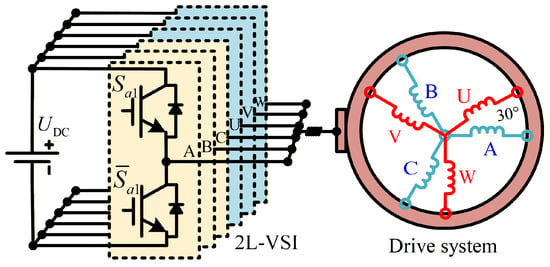
Figure 1.
The winding topology of the DTP-PMSM.
In the natural coordinate system, the voltage and flux linkage equations of the DTP-PMSM are given by []
where , , and denote the stator phase voltage, phase current, and stator phase flux linkage, respectively. , , and represent the stator resistance, inductance, and flux linkage coefficient matrix, respectively. is the amplitude of the permanent magnet (PM) flux linkage, and denotes the rotor electrical angle.
Considering the vector space decomposition (VSD) matrix and the rotation matrix [],
where is a two-dimensional zero matrix. After VSD decoupling, the phase variable in the natural coordinate system can be divided into three orthogonal subspaces, i.e., the subspace (also named the fundamental subspace), subspace (also named the secondary subspace), and subspace. The current component of the subspace adjusts torque/flux production, while the current component of the subspace is related to harmonics, resulting in copper loss. Due to the isolated neutral point of the DTP-PMSM studied in this article, the current component of the subspace cannot flow.
By substituting (2) and (3) into (1), The ideal mathematical model of the DTP-PMSM in the rotation reference frame can be expressed as
where are the stator currents and are the stator voltage vectors on the and axes. and are the two stator inductances on the axis. When the DTP-PMSM has a surface-mounted assembly, . is the leakage self-inductance on the axis. is the electrical rotor speed.
Owing to the distinctive topology and remarkable performance advantages of DTP-PMSMs, they have been widely adopted in various drive systems. As illustrated in Figure 2, different application domains impose requirements on drive system performance. In electric vehicles [], the motor must exhibit high power density to minimize size and weight, as well as high efficiency to extend driving range, while ensuring smooth low-speed operation and energy-efficient output. In electric aircraft [], the responsiveness and precision of the drive system directly affect flight safety. These applications all demand that current control systems achieve both fast dynamic response and excellent steady-state performance with strong robustness under complex disturbances.
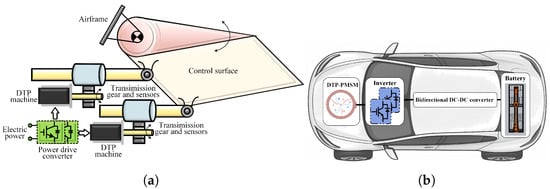
Figure 2.
Schematic diagrams of DTP-PMSM-based drive systems. (a) Electric actuation system for aircraft; (b) electric vehicle system.
Therefore, a deep analysis of disturbance characteristics and the development of effective modulation and control strategies to suppress such disturbances are crucial for fully exploiting the potential of DTP-PMSMs.
3. Basic Bi-Subspace VVPCC Scheme and Its Disturbance Analysis of DTP-PMSMs
In this section, the ideal mathematical model of basic bi-subspace VVPCC with an improved Park transformation for a DTP-PMSM is presented, and then the different types of disturbances are discussed in terms of DC and AC factors.
3.1. Basic Bi-Subspace VVPCC Scheme
The state of each 2L-VSI leg is identified by binary values: when the upper switch is “ON”, , and when the upper switch is “OFF”, . Therefore, there are 64 different switching states for the 2L-VSI marked as a vector . Considering the DC-link () voltage and the transformation from switch to phase value, the phase vector can be derived from a single three-phase system and defined as follows []:
When implementing a PCC strategy based on full enumeration operations, the digital processor needs to process 49 predictions, which incurs a large computational burden. Furthermore, when implementing the VVPCC strategy, the computational burden is significantly reduced and only 12 prediction operations are required, as discussed in []. However, the subspace is in an open loop, which weakens the steady-state performance of the system to some extent.
In order to realize independent drives in two subspaces simultaneously, a bi-subspace VVPCC framework based on deadbeat control is established, as shown in Figure 3. Specifically, non-zero virtual vectors consist of a large vector and a medium-large vector, and their magnitude in both subspaces is . Under the constraint of total duration, the duration of the large vector is and that of the medium-large vector is . After processing, the virtual vectors of the subspace can adjust the current components without interfering with the control of the subspace. In contrast, the virtual vectors of the subspace only control the current component without affecting flux and torque adjustment by the current components.
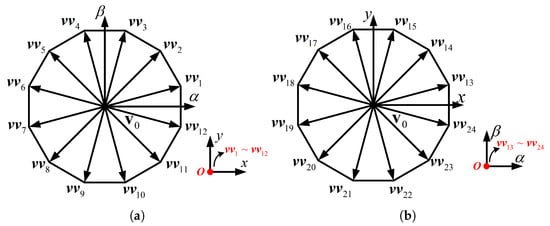
Figure 3.
Non-zero virtual voltage vectors. (a) subspace; (b) subspace.
Taking the Euler forward function into account and applying it to (4) and (5), the prediction equation for the stator current at the next sampling instant is then employed as follows:
where is a two-dimensional identity matrix and is the sampling period. And
It should be noted that for digital processors, the algorithm prediction and pulse width modulation (PWM) update cannot be completed immediately, and the PWM is generally updated during the next sampling period. Consequently, discrete stator current models (7) and (8) can be rewritten with a sampling delay as
The predicted stator currents at the instant are obtained using discrete models (12) and (13) for 12 virtual vectors . Since the virtual vectors in the two subspaces have an average zero-voltage component during the sampling period, the cost function can be simplified with an advance of a sampling period as follows:
where is the reference value of the axis and axis. Minimizing cost functions (14) and (15) can find the optimal virtual vectors of the axis and axis. In addition, under the constraint of the total duration, the duty cycles of the axis and axis are obtained through a constraint to ensure that [0,1]. Further details about the implementation of VVPCC can be found in [,]. Figure 4 shows the block diagram of the basic bi-subspace frame. Based on the separation treatment in Figure 3, the DTP-PMSM can achieve independent control of the two subspaces electrically.
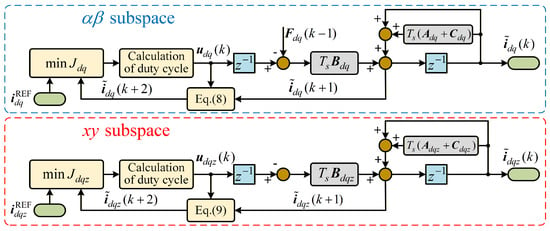
Figure 4.
Block diagram of the basic bi-subspace frame.
3.2. Disturbance Analysis of DTP-PMSMs
Due to the complex actual working conditions of DTP-PMSMs, the implementation of MPC for the actuation system is limited. From Figure 4, it can be seen that the PCC methods for the subspace and the subspace are highly dependent on the model parameters of the DTP machine. Due to the variations in cavity temperature during operation, the performance of the current sensor sampling chain is inevitably affected, leading to sampling errors. Consequently, the nominal model parameters may deviate from the pre-modeled values, resulting in a reduction in the accuracy of the MPC and affecting the final output performance, which is the main cause of DC disturbances. In addition, the control systems of the DTP machine also contain AC disturbances, such as nonlinearities of the power converters, machine asymmetries, and back-EMF harmonics. From the mathematical analysis, regardless of DC disturbances or AC disturbances, there will be a deviation between the predicted value and the reference value. Therefore, it is necessary to optimize the MPC strategy to deal with these disturbances in order to obtain better current loop performance. Specific descriptions of DC and AC disturbances are presented below with the symbols and , respectively.
3.2.1. DC Disturbance and Its Compensation
As analyzed above, the main reason for DC disturbances is the parameter mismatch caused by current-sampling errors and other unmodeled dynamic factors. Then the DC disturbance is defined as follows:
where represents the DC disturbance caused by parameter mismatch. represents the DC disturbance caused by the unmodeled dynamic factors. is a non-fixed function symbol. In order to incorporate the parameter mismatch into the system models, (12) and (13), the parameters can be defined as follows:
where the terms are the normal values of the stator resistance, stator inductance of the axis, and PM flux linkage, respectively. The terms are the actual parameters. The terms are the associated parameter mismatch errors. Since DC disturbance has a greater impact on the tracking performance of the current, the analysis of the parameter mismatch is limited to the subspace. The coefficient matrices with the associated errors are rewritten as follows:
Then, the component of parameter mismatch can be given by
Finally, taking the DC disturbance into account, the model of predictive stator current (12) in the axis can be rewritten as follows:
where represents the corrected current on the axis with DC disturbance at the kth instant.
3.2.2. AC Disturbance and Its Compensation
In the steady-state operation of DTP-PMSMs, AC disturbances occur mainly periodically, resulting in non-ideal sinusoidal phase currents embedded in fifth and seventh harmonic components. When only the fifth and seventh harmonics are considered, the six-phase currents can be expressed as follows:
where and are the amplitudes of the fifth and seventh harmonics, respectively. is the electrical offset angle between two sets of windings. After VSD operation, the stator currents in the subspace and subspace are expressed as follows:
By applying to (22) in the subspace, the fifth and seventh harmonics will be converted to the sixth harmonic, shown in (23), where the terms are the -axis sixth current harmonics.
We define and as the harmonics caused by the distorted voltage component and the distorted flux component in the frame, respectively. Consequently, the AC disturbance can be defined as follows:
where is a non-fixed function symbol.
Taking the AC disturbance into account, the model of predictive stator current (13) in the axis can be rewritten as follows:
where represents the corrected current of -axis with AC disturbance at kth instant. As reported in [], when the sixth harmonic component of the coordinate is effectively optimized, the fifth and seventh harmonic components of each phase current are also suppressed.
4. Principle of Proposed En-BSVVPCC Scheme
4.1. Disturbances Attenuation and Controller Design
In order to overcome the influence of DC and AC disturbances on the current loop performance, in combination with the basic bi-subspace VVPCC scheme, this article proposes an En-BSVVPCC scheme with a DESO for the subspace and a DVRC for the subspace. Figure 5 shows a block diagram of the proposed En-BSVVPCC scheme in the DTP-PMSM drivers.
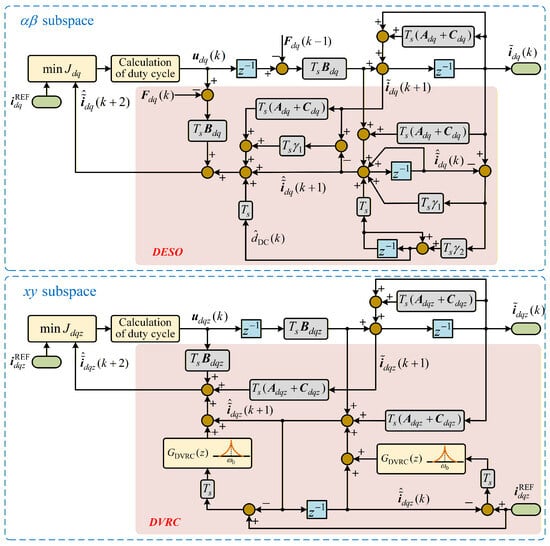
Figure 5.
Block diagram of the proposed BSVVPCC scheme in the DTP machine drivers.
From Figure 5, it can be seen that the proposed En-BSVVPCC scheme is mainly designed for the current loop, and the speed loop uses the discrete proportional–integral (PI) controller to generate the q-axis reference current (). In order to achieve better static decoupling and reduce the amplitude of the harmonic current, the reference currents of the d-axis, -axis, -axis are set to 0, i.e., . The current loop consists of three main parts: the basic bi-subspace frame, a DESO for the subspace, and a DVRC for the subspace. Note that the main contribution of the DESO is to eliminate the influence of DC disturbances, and that the main contribution of the DVRC is to eliminate the fifth and seventh current harmonics, which work together to correct the duty cycle applied in the inverter.
Due to the basic bi-subspace framework, the implementation of the DESO and DVRC can be carried out as parallel tasks, executing the following two tasks separately.
4.1.1. Design of DESO for the Subspace
The state-space representation can be derived from (20) as follows:
where is the first-order difference of the actual disturbance .
According to (26), the predictive stator current model using the normal parameters and DESO can be written as follows:
where is the estimated stator current using the DESO in the -axis. is the estimated DC disturbance. The terms are the active gains of the designed ESO. In this part, the DESO will address two key issues. The first is to estimate the value of DC disturbances, the other is to predict the -axis current value for the next sampling period.
4.1.2. Design of DVRC for the Subspace
From (21) to (24), the fifth and seventh harmonics are the main components of AC disturbance, and the sixth harmonics of the -axis can be selectively suppressed to achieve higher output current quality. The proposed solution of this article is to apply a DVRC, which can be defined in the S domain as follows:
where is the electrical constant of the subspace. is the gain. is the cutoff frequency of the DVRC. is the resonant frequency of the DVRC.
In practical engineering applications, the DVRC needs to be discretized. In order to reduce the discretization error and achieve more accurate harmonic suppression, pre-distorted Tustin is used to discretize the DVRC, and the discretization operator is represented as follows:
For the convenience of analysis, a coefficient is set as
and substituting (29) into (28), the DVRC is derived as follows:
where
According to (25), the predictive stator current model using (31) can be written as follows:
where is the corrected stator current using the DVRC in the -axis. Consequently, after obtaining the corrected and , the optimal voltage vector following correction can be determined by re-substituting them into (14) for and (15) for . At this point, two independent MPC adjustments have been completed.
4.2. Optimized PWM Generation
In order to further discuss the differences before and after the optimization of the PWM sequence, the two optimal non-zero virtual voltage vectors corresponding to the two subspaces are taken as an example in this section, i.e., for the subspace and for the subspace. Then, their specific PWM switching pattern is shown in Figure 5, where () are the duration of the virtual vector and zero vector in the subspace and subspace, respectively. In addition, and .
Since the above two optimal vectors are used to drive the DTP machine at the same time and the optimized switching sequence is not taken into account, the switching pattern of PWM is shown in Figure 6a. This leads to frequent switching on and off of the bridge arm switching devices and an increase in losses. Therefore, centering all high levels is a quick and simple processing method, shown in Figure 6b, which allows the mean leg voltages to remain unchanged. In addition, if the duration of the two applied non-zero vectors does not exceed , the remaining time will apply the zero voltage vectors.
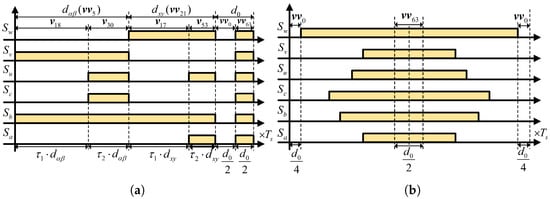
Figure 6.
Switching pattern used to combine for the subspace and for the subspace. (a) Before optimization; (b) after optimization.
4.3. Stability Analysis of the Model-Assisted DESO
From (37), the characteristic equation of the model-assisted DESO is derived as follows
The real characteristic equation of the error system can be written as
where
Based on the Jury criterion [], the necessary and sufficient condition for DESO stability can be expressed as
By substituting and , it follows that
Once condition (46) is fulfilled, the DESO achieves stability, ensuring that can converge to and can converge to . According to [], the DESO gains can be selected as and , where represents the bandwidth of the DESO. Based on (46), the selection range of can then be derived as follows:
According to (46), after introducing the model term , the overall stability region of the system shifts toward the direction of smaller . This implies that the model-assisted DESO can maintain stability even with relatively small observer gains. Consequently, under the same gain conditions, the model-assisted DESO achieves faster convergence and stronger robustness compared with the conventional DESO.
4.4. Guidelines for Parameter Selection
This subsection provides guidelines for tuning the parameters of the proposed bi-subspace VVPCC with model-assisted DESO and DVRC. The objective is to balance disturbance attenuation, closed-loop stability, and real-time implementation. The tuning rules are as follows:
- DESO bandwidth : For the model-assisted DESO in (27), the motor parameters in the coefficient matrices are fixed by the experimental platform. The only parameter to tune is . The stability analysis provides an admissible range in (47). Within this range, the bandwidth is determined by balancing disturbance-rejection capability against noise amplification, using empirical bandwidth selection approaches [,,].
- DVRC resonant frequency : Set the DVRC resonant frequency to six times the electrical fundamental and adjust it with the machine speed so that the dominant harmonics mapped to the frame remain selectively attenuated.
- DVRC cutoff frequency : The determines the resonant bandwidth and phase characteristics: A larger broadens the attenuation band but introduces more phase lag. A smaller improves phase margin and dynamic stability but may under-attenuate when the harmonic center drifts. Hence, choose by balancing the expected harmonic variation and the desired transient performance.
- DVRC resonant gain : The resonant gain determines the depth of harmonic attenuation. It is typically initialized with a small value and gradually increased until the target harmonic is effectively reduced. If oscillatory behavior or sluggish transient responses are observed, a lower or a smaller cutoff frequency should be adopted to achieve a more desirable compromise between harmonic suppression and system stability.
5. Experimental Evaluation
In this section, the differences in physical properties between the proposed En-BSVVPCC method and the single VVPCC (SVV-PCC) method reported in [] are evaluated through experiments and are specifically presented. The test experiment platform is shown in Figure 7. The two methods were tested on a DTP-PMSM driven by two three-phase 2L-VSIs. The three-phase PMSM (TP-PMSM), as the load machine, can be externally connected with a constant load resistor or be directly controlled using a PI-FOC technology. The two PMSMs were connected by a coaxial connector. The two PCC strategies were compiled on Matlab/Simulink 2021a software and then deployed on the Links-Box-03 real-time platform, which runs the VxWorks operating system at a frequency of 2.7 GHz. In Figure 7, the stator currents generated by the DTP-PMSM and the DC-link voltage are measured by six current sensors and a voltage sensor. An incremental encoder with 2500 pulses per revolution was used to measure the actual rotor position. The switching signals are sent to the VSIs after being modulated. The key preset parameters in the testing process are listed in Table 1.
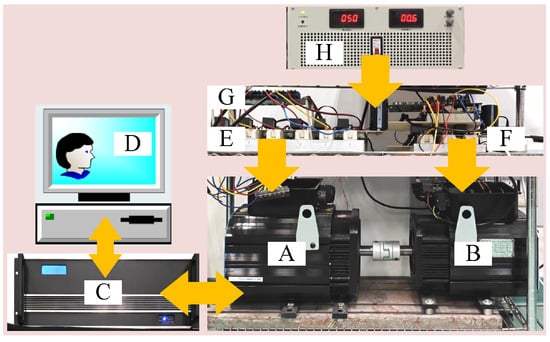
Figure 7.
Experimental platform of the electrical drives. A: The tested master DTP-PMSM; B: the slave TP-PMSM as a load machine; C: Links-Box-03 real-time operating system; D: MATLAB/SIMULINK 2021a and control interface; E: two VSCs for the DTP-PMSM; F: a VSC for the TP-PMSM; G: the analog-to-digital converter; H: the DC-link power source.

Table 1.
Key parameters of DTP-PMSM.
Since the parameters of two PMSMs are involved, to facilitate the distinction between different test conditions, this paper employs the “@” symbol to differentiate the operational states of the master and slave motors. For instance, “@100 rpm” indicates that the master DTP-PMSM is configured with a reference current while the slave TP-PMSM maintains a rotational speed of 100 rpm to provide load torque, and analogous interpretations apply to other cases.
To ensure objectivity, two methods were implemented on the same experimental platform with the following conditions:
- The sampling period, model discretization, and motor parameters are identical.
- The cost-function weights are set to 1.
- The amplitude of the virtual voltage vector is set to 0.598 × , the duration of the large vector is 0.732 × , and that of the medium-large vector is 0.268 × . All values are adopted according to [].
- PWM updating and delay compensation are identical.
Since SVV-PCC is a modulation-level model predictive control scheme, its performance is uniquely determined by the implementation conditions. Therefore, under identical experimental settings, SVV-PCC already operates at its attainable optimal performance. In addition, The gain parameter of the DESO was configured as , while the cutoff frequency of the DVRC was set to , with parameter .
5.1. Current Single-Closed-Loop Performance Evaluation
5.1.1. Step Response Performance Evaluation of Reference Current
To clearly demonstrate the dynamic behavior of the reference current , Figure 8 presents the experimental waveforms of with a step change from 0 A to 4 A over five fundamental periods (5 Hz). The subfigures from left to right correspond to the current control techniques based on the SVV-PCC method and the proposed En-BSVVPCC method, respectively. Within each subfigure, the waveforms from top to bottom represent the phase A () and phase A () currents of the DTP-PMSM, -axis stator current components in the subspace, and -axis stator current components in the subspace. From Figure 8, it can be observed that both the SVV-PCC method and the proposed En-BSVVPCC method achieve steady-state tracking within one fundamental period (<0.2 s). In terms of response time, the SVV-PCC method slightly outperforms the proposed En-BSVVPCC method, which may be attributed to the increased computational burden of the latter. Regarding the tracking performance of and harmonic current , it is evident that the control accuracy of the classical SVV-PCC method is compromised under practical DC and AC disturbances, whereas the proposed En-BSVVPCC method demonstrates significant advantages in suppressing both steady-state errors and AC errors.
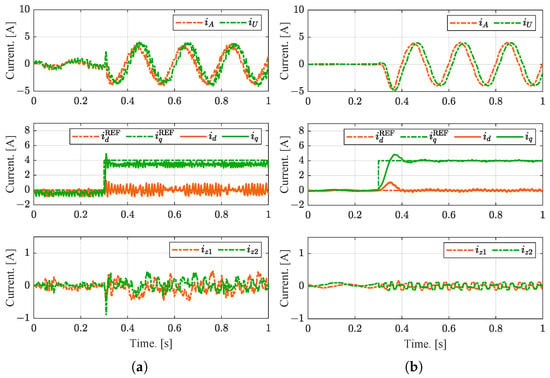
Figure 8.
Experimental waveform of the step response of from 0 A to 4 A under the “@100 rpm” condition. (a) SVV-PCC method. (b) Proposed En-BSVVPCC method.
5.1.2. Steady-State Performance Evaluation of Current Loop Under Different Reference Currents
To comprehensively compare the steady-state current loop performance between the SVV-PCC method and the proposed En-BSVVPCC method, this paper tested the root mean squared error (RMSE) of the four-dimensional currents and as well as the total harmonic distortion (THD) of for the DTP-PMSM under three operating conditions: “@100 rpm”, “@100 rpm”, and “@100 rpm”. The essential data are summarized in Table 2. They reveal that the proposed En-DSVVPCC method exhibits smaller steady-state ripples in and compared to the SVV-PCC method under varying reference current conditions. Additionally, the more stable outputs of the proposed En-BSVVPCC method across diverse operating scenarios indirectly confirm its enhanced robustness.

Table 2.
Steady-state test results of the current loop using different values under the @100 rpm condition.
5.1.3. Speed Regulation Performance Evaluation Under Constant-Torque Operation
To further investigate the output characteristics of the DTP-PMSM current loop under varying load torques, this paper maintains a constant output torque (corresponding to the reference current ) and evaluates the system under speed variation from 50 rpm to 200 rpm and back to 50 rpm. The output characteristics of the current loop are shown in Figure 9. In the phase current waveforms, the SVV-PCC method exhibits noticeable distortion during speed transitions, whereas the proposed En-BSVVPCC maintains smooth and stable profiles across all operating conditions. This improvement stems from the enhanced modulation mechanism, which effectively mitigates the impact of voltage distortion on current response. In contrast, the conventional method suffers from model parameter mismatches and unmodeled disturbances, leading to steady-state errors in and pronounced fluctuations in the -axis. By incorporating the DESO, the proposed method precisely estimates and compensates DC disturbances, thereby eliminating steady-state error and improving tracking accuracy. Moreover, the current ripples in the -axis are significantly reduced. Although minor transient deviations occur during speed transitions, the system rapidly returns to steady-state operation. In addition, the DVRC used in the subspace suppresses the dominant harmonic currents over the tested speed range.
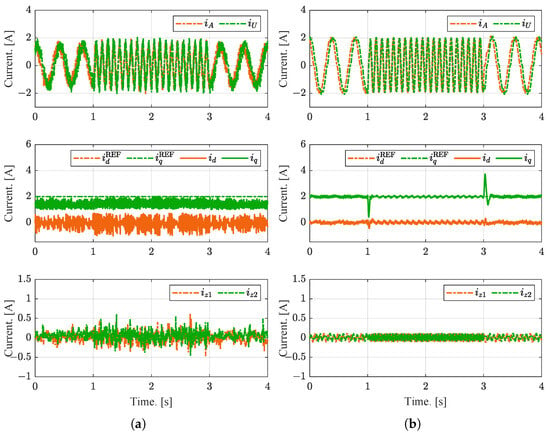
Figure 9.
Experimental waveforms when TP-PMSM speed was varied from 50 rpm to 200 rpm and back to 50 rpm under the condition of constant torque at “@”. (a) SVV-PCC method. (b) Proposed En-BSVVPCC method.
As evidenced by the results, En-BSVVPCC exhibits stronger robustness and higher current sinusoidality under dynamic operating conditions compared with SVV-PCC, achieving lower torque ripple, reduced energy loss, and superior disturbance rejection.
5.2. Current–Speed Dual-Loop Performance Evaluation
The current–speed dual-loop testing was configured with the DTP-PMSM as the controlled motor, employing the classical SVV-PCC method and the proposed En-BSVVPCC method for closed-loop current loop control, while the speed loop utilized a classical PI controller with a proportional gain and an integral gain . Additionally, the TP-PMSM was deactivated as a load source; instead, three external resistors were connected in series with the three-phase windings after de-energization to serve as a fixed load.
5.2.1. Loaded-Torque Start-Up Performance Evaluation
In drive systems, high-inertia loads are typically integrated, necessitating further investigation into the output performance of DTP-PMSMs during loaded-torque starting. This study configured the DTP-PMSM to transition directly from standstill to 200 rpm. As illustrated in Figure 10, the results sequentially demonstrate (from top to bottom) the mechanical speed N, phase currents and , stator current , and harmonic current of the DTP-PMSM. Quantitative dynamic metrics are provided in Table 3.
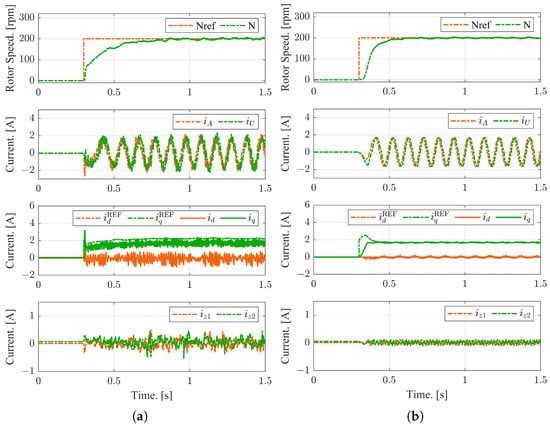
Figure 10.
Experimental results of the DTP-PMSM start-up test under the loaded-torque condition. (a) SVV-PCC method. (b) Proposed En-BSVVPCC method.

Table 3.
Comparison of DTP-PMSM dynamic metrics during loaded-torque start-up testing.
Comparative analysis reveals that the proposed En-BSVVPCC method outperforms the SVV-PCC method in both transient response and steady-state performance. Specifically, the rise time is reduced by 50% and the settling time by 62%, allowing the system to achieve faster speed tracking. Moreover, The phase currents and -axis components converge quickly to their references, effectively avoiding the overshoot and short-term oscillations observed in the SVV-PCC method during the initial transient. Notably, the harmonic current amplitude range decreases from ±0.35 A to ±0.08 A, representing a reduction of 77%. These improvements are attributed to the compensation of prediction errors induced by nonlinear disturbances in the proposed method, which enhances the closed-loop gain of the current loop and consequently accelerates the tracking response of the speed loop.
Overall, the reduced current harmonics and faster convergence directly translate into lower torque ripple and higher energy efficiency. These attributes are particularly important for high-inertia applications requiring smooth acceleration and high stability, thus improving the reliability of industrial drive systems under loaded-torque start-up conditions.
5.2.2. Step Load Torque Transient Performance Evaluation
To investigate the robustness of the proposed En-BSVVPCC method under load variation scenarios, this study configured the DTP-PMSM to operate under constant-power conditions and conducted step load torque increase/decrease tests. As shown in Figure 11, a step load torque increase was applied at 1 s, followed by 2 s of steady-state operation, after which a step load torque decrease was implemented at 3 s. Notably, load torque variations under constant-power operation induce speed ripples, with the maximum/minimum speeds and their absolute errors quantified in Table 4. Both the experimental waveforms and tabulated data demonstrate that the proposed En-BSVVPCC method achieves smaller speed deviations and smoother current response during load-step transients compared to the SVV-PCC method. Specifically, as shown in Figure 11b, the tracking oscillations of at the torque step are markedly reduced, and remains essentially at its reference, whereas the SVV-PCC method in Figure 11a presents larger ripple and transient chattering. Across different load-torque levels, En-BSVVPCC consistently maintains low current harmonics and smooth phase-current waveforms, further highlighting its superior performance.
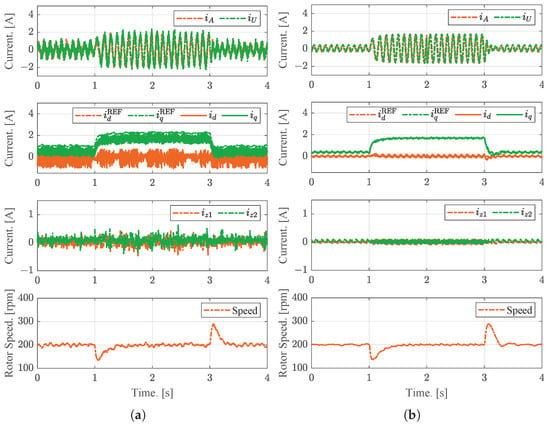
Figure 11.
Experimental results of step load torque transient test under constant-speed “200 rpm@” condition. (a) SVV-PCC method. (b) Proposed En-BSVVPCC method.

Table 4.
Comparison of dynamic metrics during step load torque transient test.
In summary, the proposed method exhibits enhanced robustness and stability under load variations, effectively mitigating speed fluctuations caused by load steps while maintaining strong disturbance rejection. Consequently, the drive system achieves higher electromechanical energy conversion efficiency and more stable operation in variable-torque scenarios.
5.3. Parameter Robustness Evaluation
The dependence of MPC on model parameter accuracy is an inherent characteristic. As previously discussed, actual parameters may deviate from nominal values during motor operation, leading to steady-state errors. The SVV-PCC method implements no error compensation, and the test results in Figure 8, Figure 9, Figure 10 and Figure 11 demonstrate significant steady-state errors in the components within the subspace. This study evaluates the parameter robustness of the proposed En-BSVVPCC method under mismatches in the stator resistance , stator inductance , and permanent magnet flux linkage . The output waveforms are shown in Figure 12. Testing conditions: All three parameters were set to 50% of their nominal values during 0–1 s, nominal values during 1–2 s, and 150% of nominal values during 2–3 s.
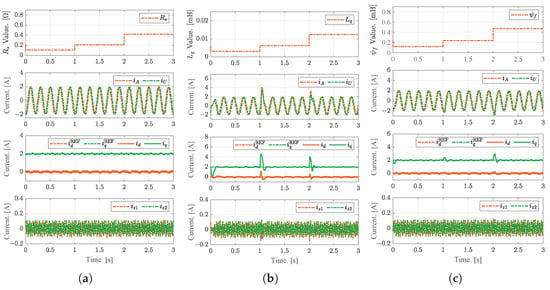
Figure 12.
Experimental results with parameter mismatch under the “@100 rpm” condition. (a) ; (b) ; (c) .
Figure 12a presents the test results under mismatch. According to (19), MPC exhibits low sensitivity to , resulting in negligible system impact despite variations.
Figure 12b illustrates the test results under stator inductance parameter mismatch. The structure of parameter matrices and determines that the system exhibits higher sensitivity to than to . When deviates from its nominal value, transient oscillations emerge in the stator current , but stable operation is restored within one fundamental period (5 Hz), confirming the robustness of the proposed En-BSVVPCC method against variations.
Figure 12c presents the test results under permanent magnet flux linkage mismatch. While is commonly treated as a constant in motor control, magnetic saturation and other factors can alter its value. Although accuracy exerts a critical influence on MPC prediction fidelity, its sensitivity is lower than that of . During mismatch, minor transient oscillations occur in , yet stable operation is also recovered within one fundamental period (5 Hz), demonstrating the method’s robustness to variations.
6. Conclusions
To address the nonlinear disturbance suppression in DTP-PMSMs, this paper proposes an En-BSVVPCC scheme. First, a bi-subspace VVPCC framework is established based on the virtual vector method, enabling independent control of the and subspaces in the stationary coordinate system. Leveraging disturbance decoupling within the BSVVPCC, a model-assisted DESO is designed in the subspace to estimate and compensate for steady-state errors, while a pole–zero cancellation-based DVRC is employed in the subspace to suppress the sixth harmonic components. Subsequently, optimal modulation voltage vectors are applied to PWM, with their switching sequences optimized by the volt-second balance principle. Finally, comprehensive experimental data across various operating scenarios indicate that the proposed En-BSVVPCC method outperforms the traditional SVVPCC approach in integrated output performance. This demonstrates that the bi-subspace predictive current control framework exhibits exceptional suppression capabilities and robustness against both AC and DC disturbances. Consequently, it further enhances the high-precision performance of drive mechanisms from both modulation and control perspectives. Moreover, the proposed method is applicable to any multi-phase motor drive control system, showcasing significant engineering application value and universality.
It should be noted that the harmonics caused by dead time that is not an integer multiple of the sampling period have not been quantitatively analyzed in this study, and will be investigated in future work.
Author Contributions
Conceptualization: W.Y. and C.Z.; methodology: W.Y. and Q.D.; formal analysis: W.Y. and C.Z.; software/simulation: W.Y. and Q.D.; designing experiments and analyzing data: W.Y. and C.Z.; writing—original draft: W.Y.; writing—review and editing: Q.D. and Y.M.; supervision: Q.B. and Y.M. All authors have read and agreed to the published version of the manuscript.
Funding
This research was supported by the National Natural Science Foundation of China under
Grant 12403089 and the Sichuan Science and Technology Program of China under Grant 2024NSFSC1492.
Institutional Review Board Statement
Not applicable.
Informed Consent Statement
Not applicable.
Data Availability Statement
Data are contained within the article.
Conflicts of Interest
The authors declare no conflicts of interest.
References
- Liu, L.; Wang, K.; Guo, L.L.; Li, J. Analysis of Inter-Turn Short Circuit Faults in Dual Three-Phase PMSM for Electromechanical Actuator. IEEE Trans. Transp. Electrif. 2023, 9, 4059–4070. [Google Scholar] [CrossRef]
- Li, L.; Zhou, W.; Bi, X.; Sun, X.; Shi, X. Second-Order Model-Based Predictive Control of Dual Three-Phase PMSM Based on Current Loop Operation Optimization. Actuators 2022, 11, 251. [Google Scholar] [CrossRef]
- Liu, H.; Li, B.; Zio, E.; Xu, W. Imbalanced Multidomain Generalization Method for Electromechanical Actuator Fault Diagnosis Under Variable Working Conditions. IEEE Trans. Instrum. Meas. 2025, 74, 1–14. [Google Scholar] [CrossRef]
- Yang, J.; Yuan, K.; Sun, X. Adaptive Sliding Mode Fault-Tolerant Control of Redundant Electro-Mechanical Actuator System. In Proceedings of the 2024 7th International Conference on Advanced Algorithms and Control Engineering (ICAACE), Shanghai, China, 1–3 March 2024; pp. 1152–1157. [Google Scholar]
- Giangrande, P.; Madonna, V.; Nuzzo, S.; Galea, M. Design of Fault-Tolerant Dual Three-Phase Winding PMSM for Helicopter Landing Gear EMA. In Proceedings of the 2018 IEEE International Conference on Electrical Systems for Aircraft, Railway, Ship Propulsion and Road Vehicles & International Transportation Electrification Conference (ESARS-ITEC), Nottingham, UK, 7–9 November 2018; pp. 1–6. [Google Scholar]
- Huang, L.; Ji, J.; Zhao, W.; Tao, T.; Cui, J. Duty-Ratio-Based Direct Torque Control with Enhanced Harmonic Current Suppression for Dual-Three-Phase Permanent Magnet Motor. IEEE Trans. Power Electron. 2022, 37, 11098–11108. [Google Scholar] [CrossRef]
- Wu, G.; Xiao, H.; Long, Z.; He, J.; Li, Z. Robust Cascaded Model-Free Tolerant Control with Parameters Mismatch Fault Diagnosis for PMSM Drive System. IEEE Sens. J. 2025, 25, 1144–1154. [Google Scholar] [CrossRef]
- Jiang, X.; Lin, C.; Xing, J.; Xu, Y.; Tian, Y. A Global-Speed-Region Voltage Angle Control Method Considering Dead-Time Effect Compensation for Permanent Magnet Synchronous Motor Drives. Actuators 2024, 13, 530. [Google Scholar] [CrossRef]
- Huang, P.S.; Tsai, C.T.; Hwang, J.C.; Lin, C.T.; Lin, Y.T. Current Harmonics Suppression of Six-Phase Permanent-Magnet Synchronous Motor Drives Using Back-Electromotive Force Harmonics Compensation. Energies 2024, 17, 6280. [Google Scholar] [CrossRef]
- Liu, X.; Miao, W.; Xu, Q.; Cao, L.; Liu, C.; Pong, P.W.T. Inter-Turn Short-Circuit Fault Detection Approach for Permanent Magnet Synchronous Machines Through Stray Magnetic Field Sensing. IEEE Sens. J. 2019, 19, 7884–7895. [Google Scholar] [CrossRef]
- Zhao, Y.; Lipo, T. Space vector PWM control of dual three-phase induction machine using vector space decomposition. IEEE Trans. Ind. Appl. 1995, 31, 1100–1109. [Google Scholar] [CrossRef]
- Goncalves, P.; Cruz, S.; Mendes, A. Finite control set model predictive control of six-phase asymmetrical machines—An overview. Energies 2019, 12, 4693. [Google Scholar] [CrossRef]
- Wang, M.; Yang, K.; Luo, Y. Long-Prediction-Horizon FCS-MPC of Six-Phase PMSM Motor Based on Merge Sorting Sphere Decoding. IEEE Trans. Energy Convers. 2025; 1–10, early access. [Google Scholar] [CrossRef]
- Gonzalez-Prieto, A.; Martin, C.; González-Prieto, I.; Duran, M.J.; Carrillo-Ríos, J.; Aciego, J.J. Hybrid Multivector FCS–MPC for Six-Phase Electric Drives. IEEE Trans. Power Electron. 2022, 37, 8988–8999. [Google Scholar] [CrossRef]
- Li, Y.; Yang, J.; Wang, J.; Li, S. Disturbance Preview Based Multistep Finite Control Set Model Predictive Current Control for PMSM. In Proceedings of the 2022 IEEE International Power Electronics and Application Conference and Exposition (PEAC), Guangzhou, China, 4–7 November 2022; pp. 361–366. [Google Scholar]
- Wu, G.; Huang, S.; Wu, Q.; Zhang, C.; Rong, F.; Hu, Y. Predictive Torque and Stator Flux Control for N*3-Phase PMSM Drives with Parameter Robustness Improvement. IEEE Trans. Power Electron. 2021, 36, 1970–1983. [Google Scholar] [CrossRef]
- Gonzalez-Prieto, I.; Duran, M.J.; Aciego, J.J.; Martin, C.; Barrero, F. Model Predictive Control of Six-Phase Induction Motor Drives Using Virtual Voltage Vectors. IEEE Trans. Ind. Electron. 2018, 65, 27–37. [Google Scholar] [CrossRef]
- Tian, M.; Wang, B.; Yu, Y.; Dong, Q.; Xu, D. Discrete-Time Repetitive Control-Based ADRC for Current Loop Disturbances Suppression of PMSM Drives. IEEE Trans. Ind. Inform. 2022, 18, 3138–3149. [Google Scholar] [CrossRef]
- Yang, Y.; Wang, Q.; Liu, X.; Wei, F. Adaptive Linear Neuron-Augmented ADRC for Harmonic Current Suppression in Dual Three-Phase PMSMs: An Optimization Strategy. IEEE J. Emerg. Sel. Top. Power Electron. 2025, 13, 6148–6160. [Google Scholar] [CrossRef]
- Yoshida, A.; Akatsu, K. Study of winding structure to reduce harmonic currents in dual three-phase motor. World Electr. Veh. J. 2023, 14, 100. [Google Scholar] [CrossRef]
- Kang, L.; Zhang, H.; Xia, J.; Qi, M.; Zhao, Y. Research on Radial Vibration Model and Low-Frequency Vibration Suppression Method in PMSM by Injecting Multiple Symmetric Harmonic Currents. Actuators 2024, 13, 448. [Google Scholar] [CrossRef]
- Türker, T.; Buyukkeles, U.; Bakan, A.F. A Robust Predictive Current Controller for PMSM Drives. IEEE Trans. Ind. Electron. 2016, 63, 3906–3914. [Google Scholar] [CrossRef]
- Wang, Y.; Liao, W.; Huang, S.; Zhang, J.; Yang, M.; Li, C.; Huang, S. A Robust DPCC for IPMSM Based on a Full Parameter Identification Method. IEEE Trans. Ind. Electron. 2023, 70, 7695–7705. [Google Scholar] [CrossRef]
- Steffen, T.; Rafaq, M.S.; Midgley, W. Comparing Different Resonant Control Approaches for Torque Ripple Minimisation in Electric Machines. Actuators 2022, 11, 349. [Google Scholar] [CrossRef]
- Yang, X.; Hu, H.; Hu, H.; Liu, Y.; He, Z. A Quasi-Resonant Extended State Observer-Based Predictive Current Control Strategy for Three-Phase PWM Rectifier. IEEE Trans. Ind. Electron. 2022, 69, 13910–13917. [Google Scholar] [CrossRef]
- Liu, X.; Deng, Y.; Cao, H.; Wang, J.; Li, H.; Lee, C.H.T. Modified ADRC Based on Quasi-Resonant Fixed-Time-Convergent Extended State Observer for PMSM Current Regulation. IEEE Trans. Transp. Electrif. 2025, 11, 1416–1430. [Google Scholar] [CrossRef]
- Yepes, A.G.; Freijedo, F.D.; Doval-Gandoy, J.; López, Ó.; Malvar, J.; Fernandez-Comesaña, P. Effects of Discretization Methods on the Performance of Resonant Controllers. IEEE Trans. Power Electron. 2010, 25, 1692–1712. [Google Scholar] [CrossRef]
- Zhang, C.; Yang, Y.; Gong, Y.; Guo, Y.; Song, H.; Zhang, J. Angle-Based RGN-Enhanced ADRC for PMSM Compressor Speed Regulation Considering Aperiodic and Periodic Disturbances. Actuators 2025, 14, 276. [Google Scholar] [CrossRef]
- Sun, X.; Lin, X.; Guo, D.; Lei, G.; Yao, M. Improved Deadbeat Predictive Current Control with Extended State Observer for Dual Three-Phase PMSMs. IEEE Trans. Power Electron. 2024, 39, 6769–6782. [Google Scholar] [CrossRef]
- Wen, S.; Dou, M.; Zhao, D. An Improved DPCC Based on a Cascade Extended State Observer with Notch Filter for PMSM Current Disturbance Suppression. IEEE J. Emerg. Sel. Top. Power Electron. 2025, 13, 3603–3617. [Google Scholar] [CrossRef]
- Li, P.; Su, J.; Wang, H.; Yang, G. Model-free predictive current control of IPMSMs based on an improved extended state observer with parallel resonant controller switching control strategy. Comput. Electr. Eng. 2025, 125, 110414. [Google Scholar] [CrossRef]
- Tian, M.; Wang, B.; Yu, Y.; Dong, Q.; Xu, D. Static-Errorless Deadbeat Predictive Current Control for PMSM Current Harmonics Suppression Based on Vector Resonant Controller. IEEE Trans. Power Electron. 2023, 38, 4585–4595. [Google Scholar] [CrossRef]
- Liu, Z.; Huang, X.; Hu, Q.; Yang, G.; Wang, Y.; Shen, J. Model-Free Predictive Current Control of PMSM Using Modified Extended State Observer. IEEE Trans. Power Electron. 2025, 40, 679–690. [Google Scholar] [CrossRef]
- Yao, Y.; Zhuang, Y.; Xie, Y.; Xu, P.; Wu, C. Prescribed Performance Global Non-Singular Fast Terminal Sliding Mode Control of PMSM Based on Linear Extended State Observer. Actuators 2025, 14, 65. [Google Scholar] [CrossRef]
- Liu, Y.C.; Laghrouche, S.; Depernet, D.; N’Diaye, A.; Djerdir, A.; Cirrincione, M. Disturbance-Observer-Based Speed Control for SPMSM Drives Using Modified Super-Twisting Algorithm and Extended State Observer. Asian J. Control 2024, 26, 1089–1102. [Google Scholar] [CrossRef]
- Liu, J.; Li, M.; Xie, E. Noncascade Structure Equivalent SMC for PMSM Driving Based on Improved ESO. IEEE Trans. Power Electron. 2025, 40, 611–624. [Google Scholar] [CrossRef]
- Gonçalves, P.F.; Cruz, S.M.; Mendes, A.M. Disturbance Observer Based Predictive Current Control of Six-Phase Permanent Magnet Synchronous Machines for the Mitigation of Steady-State Errors and Current Harmonics. IEEE Trans. Ind. Electron. 2021, 69, 130–140. [Google Scholar] [CrossRef]
- Hossain, M.S.; Said, N.A.M.; Hasan, M.A.; Abd Halim, W.; Munim, W.N.W.A.; Jidin, A. Performance Evaluation of a Nearest Level Control-Based TCHB Multilevel Inverter for PMSM Motors in Electric Vehicle Systems. Results Eng. 2025, 25, 103949. [Google Scholar] [CrossRef]
- Gonçalves, P.F.C.; Cruz, S.M.A.; Mendes, A.M.S. Predictive Current Control Based on Variable Amplitude Virtual Vectors for Six-Phase Permanent Magnet Synchronous Machines. In Proceedings of the 2019 IEEE International Conference on Industrial Technology (ICIT), Melbourne, VIC, Australia, 13–15 February 2019; pp. 310–316. [Google Scholar]
- Sul, S.K. Control of Electric Machine Drive Systems; John Wiley & Sons: Hoboken, NJ, USA, 2011. [Google Scholar]
Disclaimer/Publisher’s Note: The statements, opinions and data contained in all publications are solely those of the individual author(s) and contributor(s) and not of MDPI and/or the editor(s). MDPI and/or the editor(s) disclaim responsibility for any injury to people or property resulting from any ideas, methods, instructions or products referred to in the content. |
© 2025 by the authors. Licensee MDPI, Basel, Switzerland. This article is an open access article distributed under the terms and conditions of the Creative Commons Attribution (CC BY) license (https://creativecommons.org/licenses/by/4.0/).